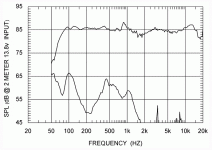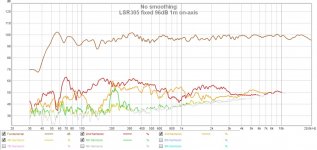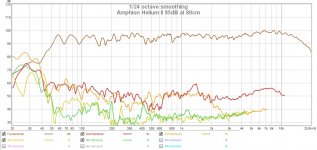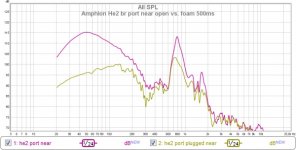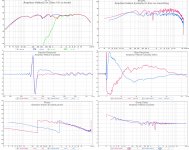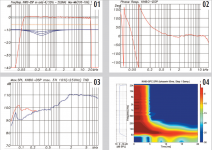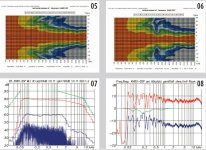There are a lot of things very wrong on the measurements... lot of distortion actually for 90db, look at the 95db ones, far from 'transparent' and a plateau of 5 db raise from 600 - 900 hz. No wonder they are good monitors to mix pop music for ipods 🙂
The phase is very good on the amphions
I don't have 95dB for LS50 so i can't compare apples and oranges.
NRCCA does distortion measurements at 90dB from 2m distance. Are you aware how loud is that at say 1m - because (besides Blade 2) all of them are nearfield monitors ? It's enough to make your ears bleed.
I don't have 95dB for LS50 so i can't compare apples and oranges.
NRCCA does distortion measurements at 90dB from 2m distance. Are you aware how loud is that at say 1m - because (besides Blade 2) all of them are nearfield monitors ? It's enough to make your ears bleed.
There are no measurements of the LS50 at 95db because they already bottom at 90 db, look around 125 hz , 10% thd, that cannot be good for the sound especially full range.
I heard them many times, and I don't like the LS50 at all.
I respect that.
What about Blade 2 ? Have you listened those and how do you like them ?
What about Blade 2 ? Have you listened those and how do you like them ?
Last edited:
This is the distortion curve I got from soundstage network.
Distortion is roughly at -20dB or 10% which I would colloquially call '**** poor' compared to the highly regarded JBL LSR305 which is active and costs a fraction of the Amphions.
As for the audibility of distortion I do not agree with Dr Geddes.
When doing the Klippel online test I found THD above 1% to be quite obvious and annoying.
Distortion is roughly at -20dB or 10% which I would colloquially call '**** poor' compared to the highly regarded JBL LSR305 which is active and costs a fraction of the Amphions.
As for the audibility of distortion I do not agree with Dr Geddes.
When doing the Klippel online test I found THD above 1% to be quite obvious and annoying.
Attachments
This is the distortion curve I got from soundstage network.
Distortion is roughly at -20dB or 10% which I would colloquially call '**** poor' compared to the highly regarded JBL LSR305 which is active and costs a fraction of the Amphions.
As for the audibility of distortion I do not agree with Dr Geddes.
When doing the Klippel online test I found THD above 1% to be quite obvious and annoying.
That is measurement of Amphion Ion+. That is 4" modwoofer playing at 90dB at 2m distance.
Do you think that there are some 4" midwoofer that wouldn't distort in that conditions ?
Feel free to post measurements.
But i have a question for you - are you familiar with near field monitor concept. Listened from 50-100cm at 75-80dB. Louder than that and you are damaging your hearing.
You've posted measurements of JBL monitor with 5" midwoofer made with different measurement equipment in different conditions. They can't be directly compared.
Last edited:
That JBL305 measurement was mine. Here is my measurement of Amphion Helium II for comparison. Same room but different location and distance. This model has oviously a SEAS alu dome and a Peerless midwoofer. Xo is asymmetric with a rather steep highpass.
The midrange distortion in NRCC measurement is obviously port noise! Port is on rearside.
The midrange distortion in NRCC measurement is obviously port noise! Port is on rearside.
Attachments
-that's excellent. Disregard that 2nd order "jump" in distortion (and resulting THD) around 1.4kHz. It would be completely inaudible with virtually all program material (being narrow band and only 2nd order in nature).
I respect that.
What about Blade 2 ? Have you listened those and how do you like them ?
Blade 2 the movie? I like it 🙂
most studio monitors are poor quality....
Plus one!
I have heard dozens of studio rigs and it never ceases to amaze me just how bad the most popular monitors are....
Amphion = bad
Genelec = even worse
PMC = So bad they should be sued under the trades description act for knowingly selling sub standard goods!
Small sealed ATC's are good, Neumann are very good.
Same size, similar drivers, same crossover trickery.
One is older and cheaper but you have to build it yourself.
I dislike Amphion almost as much as I like Genelec.
Plus one!
I have heard dozens of studio rigs and it never ceases to amaze me just how bad the most popular monitors are....
Amphion = bad
Genelec = even worse
PMC = So bad they should be sued under the trades description act for knowingly selling sub standard goods!
Small sealed ATC's are good, Neumann are very good.
Plus one!
I have heard dozens of studio rigs and it never ceases to amaze me just how bad the most popular monitors are....
Amphion = bad
Genelec = even worse
PMC = So bad they should be sued under the trades description act for knowingly selling sub standard goods!
Small sealed ATC's are good, Neumann are very good.
Neumann have some of the most detailed spec sheets I've seen for pro studio monitors. Would love to hear their largest model.
Yes Neumann are very good at sharing technical data and design benefits.... I think the microphone heritage is a great knowledge base.
As the OP, I will share what I summarized that was helpful to me.
There are several viable ways to accomplish decent results, in different applications from crossing high, and also crossing low. However,
In most applications, it is better to cross as low as possible, WITHOUT straining the tweeter's abilities, in most 2-way speaker applications.
When building 3 or 4 way speakers, dynamics become a stronger reality, and it is often actually better to let a dedicated midrange play up even above 3500 or so, as long as the midrange is fully capable, before handing off to the tweeter.
MANY other parameters go into the considerations and possibilities of crossover points, mostly for each speaker's intended purpose.
This is my summary. Did I miss anything important, please? Thanks
There are several viable ways to accomplish decent results, in different applications from crossing high, and also crossing low. However,
In most applications, it is better to cross as low as possible, WITHOUT straining the tweeter's abilities, in most 2-way speaker applications.
When building 3 or 4 way speakers, dynamics become a stronger reality, and it is often actually better to let a dedicated midrange play up even above 3500 or so, as long as the midrange is fully capable, before handing off to the tweeter.
MANY other parameters go into the considerations and possibilities of crossover points, mostly for each speaker's intended purpose.
This is my summary. Did I miss anything important, please? Thanks
Did I miss anything important, please? Thanks
The few posts above have suggested slightly before your post, that the highest quality near field studio loudspeakers manufacturers (Neumann and ATC) seems to use largest radiating surface as possible apparently 😉
But i have a question for you - are you familiar with near field monitor concept. Listened from 50-100cm at 75-80dB. Louder than that and you are damaging your hearing.
I listen almost exclusively in nearfield conditions.
Not surprising since I came into speakers from a recording/studio background.
If I listen at an average of 80dB I insist on speakers being capable of reproducing 95-100dB cleanly since sufficient headroom is probably the most important aspect of good, accurate reproduction and 12dB is the absolute minimum amount of HR acceptable to me.
As for a 5" or so driver (SEAS market the driver in question as a 4.5") that plays cleaner try the BMS5S11.
Curves
Note that these were taken at 110dB and 100W input.
Haven't measured it but I suspect the FaitalPro 5FE120 also measures substantially better than the one used by Amphion.
I listen almost exclusively in nearfield conditions.
Not surprising since I came into speakers from a recording/studio background.
If I listen at an average of 80dB I insist on speakers being capable of reproducing 95-100dB cleanly since sufficient headroom is probably the most important aspect of good, accurate reproduction and 12dB is the absolute minimum amount of HR acceptable to me.
As for a 5" or so driver (SEAS market the driver in question as a 4.5") that plays cleaner try the BMS5S11.
Curves
Note that these were taken at 110dB and 100W input.
Haven't measured it but I suspect the FaitalPro 5FE120 also measures substantially better than the one used by Amphion.
I question your work then (coming from studio recording background) since you are trying to compare apples to oranges. You are grasping on straws by saying that L12 is declared as 4.5" since it has Sd=50cm2 and trying to compare it to 5FE120 (Sd=80cm2) and BMS 5S117 (Sd=85cm2). Both of them have >50% larger Sd and one of them have significantly higher Fs.
So, you are comparing 4" home mid-woofer to 5" pro mid-range and 5" mid-woofer. You are either ignorant or trying to spin the story.
As for your +12dB demands for nearfield, check the math, Ion might be playing few dB louder (when measured for distortion) then you ask of your monitors. I mean - i don't have particularly good opinion about Ion+ also but they aren't as bad as you try to make them. They are average performance 4" monitors, that's all. If it was me, i'd buy Neumann KH80DSP.
Can we have constructive conversation where we could compare similar components with measurements made in same conditions ? If not, just say so - i'll shut up.
Speaking of Neumann, they didn't make their KH line of monitors so microphone heritage is of no significance there. They are subsidiary of Sennheiser who bought Klein+Hummel (when the company went down) then studio monitor went under the Neumann labell - prefix in their model labelling KH - out of respect, i presume, for Klein+Hummel. K+H made almost all of monitors that are offered today by Neumann but with classical active crossovers rather than DSP. Neumann introduced DSP processing when they took over the studio division and made few things better in very good monitors as K+H already were.
Last edited:
Here are measurements for Neumann KH80DSP. Look at the vertical polar responce. It measures almost as coaxial loudspeaker - having a waveguide and crossover point being very low. Outstanding in every way possible.
This is clearly the case when midwoofer is crossed over much lower than where waveguide has control - so this is how it measures at 1800Hz crossover point. I hope this answers your boggle.
Got no issue with the tweeter as such but going by its size the waveguide loses control below 2.5k while the tweeter is crossed in at 1.5KHz
This is clearly the case when midwoofer is crossed over much lower than where waveguide has control - so this is how it measures at 1800Hz crossover point. I hope this answers your boggle.
Attachments
Last edited:
I'd agree with mr. Darwin here. I have two pairs of PA coaxials at home - a pair of 15 inch B&C's in my living room and a pair of 18Sound 8-inchers sitting atop my desk in my study - both crossed over under 2kHz. The 15-inchers are crossed at 1,2k and the smaller 8-inchers at 1,8k, and both render female voices rather better than I've heard any a more conventional multiway speaker perform. Especially the smaller ones - maybe since they're being enjoyed in the nearfield, at an arms length maybe - make e.g. Melody Gardot sound quite enticing, to put it nicely.
Which 18 Sound 8" is that?
It is very interesting to design a good XO which can be right electrically speaking at test frequencies, like sweep tones and low harmonics, and low intermodulation for two tones.
However, how can you hope to even get this signal out of the inductors and capacitors splitters with a likeliness to the original: It is technically impossible: see attachment.
However, how can you hope to even get this signal out of the inductors and capacitors splitters with a likeliness to the original: It is technically impossible: see attachment.
Attachments
- Status
- Not open for further replies.
- Home
- Loudspeakers
- Multi-Way
- Tweeter playing low is desireable ... WHY ?
